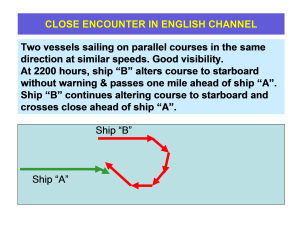The Charity
Aviation
Maritime
ColReg Competency

Initial Report
Report Text:
I was the officer on watch on my vessel “A”. We were proceeding on course 110 deg at speed approx 13.6 knots in the Western Approaches to the English Channel in good visibility. Another vessel “B” was proceeding parallel on the same course and speed, about 6 nm ahead, approximately twenty-five degrees on my port bow. General traffic situation was clear without any potential collision risks for either vessel.
At 2200 hours vessel “B” started altering course to starboard. The green navigational light of vessel “B” became visible. It appeared that vessel “B” intended to cross about one mile ahead me. I made a VHF call identifying myself and my relative position to the vessel “B”. I brought the attention of the OOW of “B” to the developing close quarter situation and requested him to take preventive action in accordance with Rule 15 of the ColRegs. At this moment the Captain of my ship arrived on bridge.
When the distance had decreased to 3 miles I made another VHF call. The OOW of “B” assured me that he would keep clear of me. Finally vessel “B” passed about 0.8 mile ahead of me.

From this moment everything happened very quickly. The situation had appeared to be safe as vessel “B” had crossed ahead of my bow and was approximately ten degrees on my starboard side; green to green, with a CPA of 0.5 mile. However she started altering course to starboard again, showing her red navigation light. We gave a signal of five short flashes on our lamp. Our Captain ordered rudder to starboard, so she crossed my bow for the second time at distance of approximately less than 0.5 nm ahead. The vessels passed port to port at full speed and with a distance of 0.25 mile. After clearing my port side the other vessel altered course more to starboard and set her course towards Falmouth.
Thirty minutes later I received a VHF call from that vessel – asking if I have “cooled down”.
CHIRP Comment:
The OOW on ship A appears to have acted prudently in calling the Captain for what turned out to be a highly unpredictable situation. Although the report does not explicitly state this, we assume that the Captain advised the OOW that he was taking over the con. Ship A appears to have taken proper action under Rule 17 to avoid a collision. We would however add that sound signals should be made in accordance with Rule 34.
We sent a summary of the report to the manager of ship B. When we originally published this report in Issue 17 of CHIRP Maritime Feedback, we had not received the full response from him. He subsequently advised that he was so concerned at the report that he had visited the ship to investigate. It transpired that the Master had not previously been aware of the incident. The Officer of the Watch was a young officer and new to the company. The ship had “time to kill” to make a pre-arranged E.T.A. at her next port. The Captain had left a night order for the OOW to do a round turn at 2200 hours before proceeding to the port. The OOW interpreted this literally, without consideration to the traffic situation (or perhaps not appreciating the manoeuvring characteristics of his vessel.)
The manager recognised that the competency assurance procedure in its recruiting process needed improvement, and introduced the use of ColReg training and testing software across his fleet.







